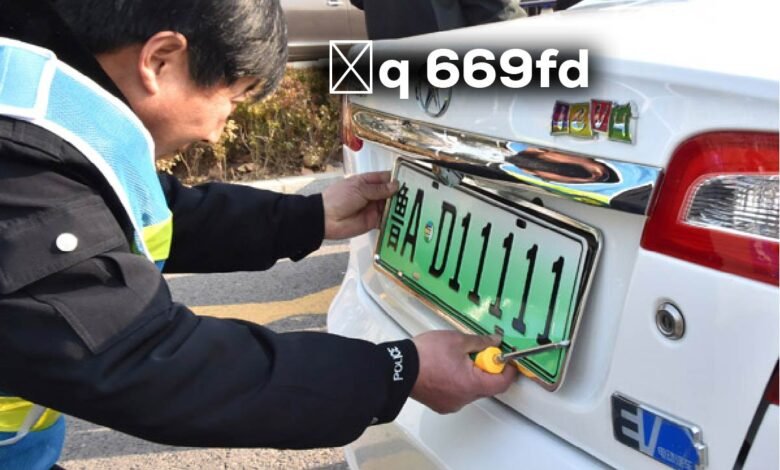鲁Q 669FD: Unraveling the Intricacies of a Unique Chinese License Plate

Introduction to 鲁Q 669FD: A Symbol of Cultural and Regulatory Significance
The Chinese license plate “鲁Q 669FD” serves as more than just a means of vehicular identification; it is a rich tapestry of cultural, regulatory, and historical significance deeply embedded in the fabric of Shandong Province. This article delves into the multifaceted aspects of the license plate 鲁Q 669FD, exploring its structure, the implications of its format, and its broader impact within the complex vehicle registration system in China. As we dissect this particular license plate, we aim to provide a comprehensive understanding that not only informs but also enhances appreciation for the meticulous regulatory and cultural nuances that define vehicle registration in one of the world’s most populous nations.
The Structure of Chinese License Plates Explained
Understanding the structure of 鲁Q 669FD requires a basic understanding of the Chinese license plate system, which is as intricate as it is functional. In China, each license plate features a regional code indicated by a Chinese character, followed by an alphabetic letter that denotes the specific category or locality within the province, and finally a sequence of numbers and letters that uniquely identifies the vehicle. The regional code “鲁” represents Shandong Province, known for its rich historical legacy and vibrant economic activity. The letter “Q” in this sequence typically points to a specific city or administrative area within Shandong, offering a clue about the vehicle’s registration location. The alphanumeric series “669FD” is what ultimately distinguishes this vehicle from millions of others, providing a unique identifier that is critical for regulatory, security, and administrative purposes.
Geographical and Cultural Implications of 鲁Q 669FD
The geographical indicator “鲁” not only tags the vehicle as registered in Shandong but also imbues it with the cultural heritage of this region. Shandong, with its historical significance as the birthplace of Confucius, has a profound impact on the cultural perceptions surrounding its license plates. The letter “Q” connects the vehicle to a specific locale, which can be an urban center or a lesser-known district, each with its own administrative protocols and cultural identity. The numbers and letters that follow, “669FD,” might be randomly assigned, but they can also carry personal or commercial significance, reflecting aspects such as auspiciousness, memorability, or branding.
Also Read 8093642079: Unraveling the Mystery Behind the Number
Regulatory Framework Surrounding 鲁Q 669FD
The allocation and management of license plates like 鲁Q 669FD are governed by a comprehensive set of regulations that ensure order and legal compliance within China’s vast automotive landscape. These regulations are designed to facilitate efficient vehicle tracking, law enforcement, and road safety. The specifics of the license plate serve not only to satisfy administrative needs but also to aid in the enforcement of traffic laws, vehicle inspections, and insurance requirements. Understanding this regulatory framework is essential for grasping how individual plates like 鲁Q 669FD function within the larger system.
The Role of 鲁Q 669FD in Traffic Management and Public Safety
License plates such as 鲁Q 669FD play a critical role in traffic management and public safety across China. By providing a clear and immediate way to identify vehicles, they help manage the flow of traffic and support law enforcement efforts in real-time. This system aids in everything from toll collection to the monitoring of traffic violations and the coordination of emergency response services. The specific design and assignment of these plates make them invaluable tools in the ongoing efforts to enhance road safety and urban planning efforts, particularly in densely populated regions like Shandong.
Technological Integration and Future Prospects of License Plates Like 鲁Q 669FD
As we navigate deeper into the 21st century, the integration of technology in vehicular management, particularly in the registration and tracking of license plates like 鲁Q 669FD, is becoming increasingly sophisticated. This integration is not only reshaping how authorities manage traffic and enforce laws but is also setting the stage for future advancements that could transform urban mobility.
Current Technological Applications
One of the most impactful technologies in this realm is Automated License Plate Recognition (ALPR). ALPR systems use high-speed cameras and sophisticated algorithms to capture and analyze license plate data in real-time. This technology is instrumental in various applications, from toll collection and congestion pricing to law enforcement and parking management. In the case of 鲁Q 669FD, such technology would allow Shandong’s traffic systems to efficiently monitor the flow of traffic, automatically detect violations, and manage vehicle-related data more effectively.
Furthermore, technology facilitates a better response to emergencies. For instance, ALPR can be used to track vehicles that are reported stolen or are involved in criminal activities. This capability is crucial for improving public safety and reducing crime rates related to vehicular theft.
Future Prospects and Innovations
Looking ahead, the potential for integrating more advanced technologies with license plate recognition systems is vast. One promising area is the use of artificial intelligence (AI) and machine learning. These technologies can enhance the accuracy and efficiency of ALPR systems, enabling them to learn from vast amounts of data and improve over time without human intervention.
Moreover, the rise of connected and autonomous vehicles presents new opportunities for using license plate data. As vehicles become more connected, license plates like 鲁Q 669FD could serve as critical nodes within a broader network of vehicular communication. This connectivity could help in managing real-time traffic conditions, optimizing routes based on traffic data, and even in environmental monitoring by identifying high-emission vehicles and regulating their access to certain areas.
Challenges and Considerations
However, with technological advancements come challenges. Privacy concerns are paramount, as the use of ALPR and other tracking technologies must balance effective management with respect for individual privacy rights. Regulations and policies will need to evolve to address these concerns, ensuring that data is used ethically and responsibly.
Additionally, the technological disparity between different regions can lead to uneven benefits from these advancements. Ensuring that rural and less economically developed areas do not lag behind in the benefits offered by these technologies will be crucial for equitable technological integration.
Conclusion: The Continuing Importance of 鲁Q 669FD
In conclusion, the license plate 鲁Q 669FD encapsulates a complex blend of cultural, regulatory, and technological elements that illustrate the sophistication of China’s vehicle registration system. As we continue to explore and understand these elements, the role of such identifiers extends beyond mere vehicle tracking—they become essential components of a broader narrative about governance, society, and technological progress in modern China. By examining the specifics of a single license plate, we gain insights into a system that affects millions of drivers daily, reflecting both historical roots and future directions in Chinese public administration and cultural identity. Whether as a symbol of regional pride, a tool for regulatory compliance, or a focal point for technological innovation, 鲁Q 669FD remains a key piece in the puzzle of China’s ongoing development and modernization efforts.
FAQs About 鲁Q 669FD
What does the “鲁” in 鲁Q 669FD represent?
The character “鲁” is a regional code that represents Shandong Province in China. It indicates that the vehicle with this license plate is registered in Shandong, a region known for its rich historical significance and economic vitality.
What does the letter “Q” signify in the license plate 鲁Q 669FD?
In the context of Chinese license plates, the letter following the regional code typically indicates a specific city or administrative area within the province. The “Q” in 鲁Q 669FD suggests that the vehicle is registered in a particular area of Shandong, which could be identified with further local knowledge.
What is the significance of the numbers and letters “669FD”?
The sequence “669FD” serves as a unique identifier for the vehicle. This part of the license plate is crucial for distinguishing the vehicle from others on the road. While “669” might just be a sequential number, “FD” could relate to specific categorizations within the vehicle registration system in Shandong.
How are license plates like 鲁Q 669FD used in traffic management?
License plates such as 鲁Q 669FD are essential tools in traffic management and law enforcement in China. They help in vehicle identification, which is crucial for toll collection, traffic law enforcement, accident management, and for providing data for traffic pattern analysis.
Can the design of 鲁Q 669FD influence its desirability or value?
Yes, in China, certain numbers and letters are considered more auspicious or desirable than others. The combination of numbers like “669” could be seen as lucky, while specific letters might hold particular appeal due to their rarity or significance in popular culture or local beliefs.
How has technology impacted the management and tracking of license plates like 鲁Q 669FD?
Technology, particularly Automated License Plate Recognition (ALPR) systems, has significantly enhanced the ability to manage and track license plates like 鲁Q 669FD. These systems allow for real-time data collection and analysis, which aids in traffic management, security measures, and environmental monitoring by identifying vehicle types and their movements across urban areas.





